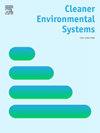Evaluating, benchmarking, and reducing embodied carbon of deep retrofit homes with significant extension: Irish case studies
IF 4.9
Q2 ENGINEERING, ENVIRONMENTAL
引用次数: 0
Abstract
Existing buildings contribute nearly 40 % of Europe's overall energy usage and represent about 36 % of the related greenhouse gas emissions from energy. Thus, the governments set retrofit targets for residential and non-residential buildings. The European Union has recently projected to transition from net-zero energy buildings to zero-carbon buildings by 2030, expanding the current building environmental performance standards to include embodied and operational carbon emissions. The study highlights the embodied carbon (EC) emissions linked to materials used in the deep retrofit measures for homes in Ireland. The research developed a novel methodology for evaluating the EC in deep retrofitted homes with defined benchmarks based on the results of the case studies. The findings show that the upfront and the whole-life EC averages of the deep retrofitted homes in Ireland are 347 and 662 kgCO2e/m2, respectively. These averages represent a benchmark for the current market practice and a starting point for developing EC reduction targets for upcoming projects. The study developed a methodology for reducing the EC of the retrofitted homes during the design stage through a group of material substitution scenarios for the most impactful materials in the case studies. Eleven materials were replaced with low-carbon alternatives available in the Irish market, resulting in an average of 23 % and 20 % reductions in the upfront and the whole-life EC emissions, respectively. Ultimately, the study is a guide for the retrofitting specialists to evaluate and compare the EC of their designs with the developed benchmarks, with solutions to achieve the reduction targets.
评估、标杆和减少深度改造住宅的隐含碳与显著扩展:爱尔兰案例研究
现有建筑占欧洲总能源使用量的近40%,占能源相关温室气体排放量的约36%。因此,政府为住宅和非住宅建筑设定了改造目标。欧盟最近计划到2030年从净零能耗建筑过渡到零碳建筑,扩大目前的建筑环境绩效标准,包括实际和运营碳排放。该研究强调了爱尔兰住宅深度改造措施中使用的材料所带来的隐含碳(EC)排放。该研究开发了一种新的方法来评估深度改造住宅的EC,并根据案例研究的结果确定了基准。研究结果表明,爱尔兰深度改造房屋的前期和全寿命EC平均值分别为347和662千克二氧化碳当量/平方米。这些平均值是当前市场实践的基准,也是为即将开展的项目制定EC减少目标的起点。该研究开发了一种方法,通过案例研究中最具影响力的材料的一组材料替代方案,在设计阶段减少改造房屋的EC。11种材料被爱尔兰市场上可用的低碳替代品所取代,导致前期和整个生命周期的EC排放平均分别减少23%和20%。最终,该研究为改造专家提供了一个指南,以评估和比较他们设计的EC与开发的基准,以及实现减排目标的解决方案。
本文章由计算机程序翻译,如有差异,请以英文原文为准。
求助全文
约1分钟内获得全文
求助全文
来源期刊

Cleaner Environmental Systems
Environmental Science-Environmental Science (miscellaneous)
CiteScore
7.80
自引率
0.00%
发文量
32
审稿时长
52 days
 求助内容:
求助内容: 应助结果提醒方式:
应助结果提醒方式:


